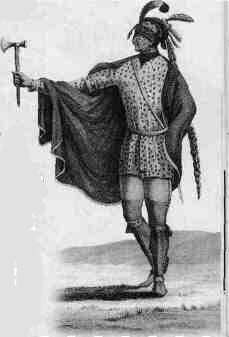Illiniwek | |
 Engraving from drawing by General Georges-Henri-Victor Collot (1796) | |
| Successor | Peoria Tribe of Indians of Oklahoma |
|---|---|
| Formation | 5 |
| Type | Tribal alliance |
| Location | |
| Origins | Mississippi River Valley |
| Membership | |
Official language | Miami–Illinois language |
Main organ | Great Chief and lower peace chiefs and war chiefs |

The Illinois Confederation, also referred to as the Illiniwek or Illini, were made up of a loosely organized group of 12 or 13 tribes who lived in the Mississippi River Valley. Eventually, member tribes occupied an area reaching from Lake Michigan to Iowa, Illinois, Missouri, and Arkansas. The five main tribes were the Cahokia, Kaskaskia, Michigamea, Peoria, and Tamaroa. [1] Other related tribes are described as the Maroa (which may have been the same as Tamaroa), Tapourao, Coiracoentanon, Espeminka, Moingwena, Chinkoa, and Chepoussa. By 1700, only the Cahokia, Kaskaskia, Michigamea, Peoria, and Tamaroa remained. Over time, these tribes continued to merge, with the Tamaroa joining the Kaskaskia, the Cahokia joining the Peoria, and with a portion of the Michigamea merging with the Kaskaskia and the remainder merging with the Quapaw. [2] [3] [4] [5] [6] [7] [8]
Contents
- Name
- History
- Formation
- Interactions with Europeans
- Dissolution
- Culture
- Language
- Gender
- Religion
- Traditions
- Society
- Economy
- Warfare
- Government
- Settlements
- See also
- Notes
- References
- Further reading
- External links
The spelling "Illinois" was derived from the transliteration by French explorers of iliniwe to the orthography of their own language. [9] [10] The tribes are estimated to have had tens of thousands of members, before the advancement of European contact in the 17th century that inhibited their growth and resulted in a marked decline in population. [10]
The Illinois, like many Native American groups, sustained themselves through agriculture, hunting, and fishing. [11] A partially nomadic group, the Illinois often lived in longhouses and wigwams, according to the season and resources that were available to them in the surrounding land. While the men usually hunted, traded, or participated in war, the women cultivated and processed their crops, created tools and clothing from game, and preserved food in various ways for storage and travel. [12] Not officially a Confederation, the villages were led by one Great Chief. The villages had several chiefs who led each individual clan. [13] The Illinois people eventually declined because of losses to infectious disease and war, mostly brought through the arrival of French colonists. [14] [11]
In 1832, the last of the Illinois homelands were being ceded, and survivors were removed to Kansas. In 1840, 200 Peoria and eight Kaskaskia were reported. In 1851, an Indian agent reported that the Peoria and the Kaskaskia, along with their allies, had intermarried among themselves and among White people to such an extent that they had practically lost their tribal identities. An 1854 treaty recognized this as a factual union and classified these groups as the Confederated Peoria. The treaty also provided for opening the Peoria-Kaskaskia and the Wea-Piankashaw reserves in Kansas to settlement by non-Indians [15] Eventually, the remnants of these tribal groups reorganized under the name of the Confederated Peoria. They are now known as the federally recognized "Peoria Tribe of Indians" and reside in present-day Oklahoma. [16]
